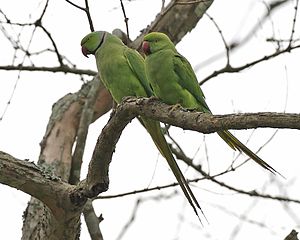Psittacula
| Psittacula | |
|---|---|

| |
| Rose-ringed parakeets in Assam, India (Psittacula krameri manillensis) | |
| Scientific classification | |
| Kingdom: | |
| Phylum: | |
| Class: | |
| Order: | |
| Superfamily: | |
| Family: | |
| Subfamily: | |
| Tribe: | |
| Genus: | Psittacula Cuvier, 1800
|
| Species | |
|
more than 15, see text | |
Members of the parrot genus Psittacula or Afro-Asian ringnecked parakeets as they are commonly known in aviculture originates found from Africa to South-East Asia. It is a widespread group, with a clear concentration of species in south Asia, but also with representatives in Africa and the islands of the Indian Ocean. This is the only genus of Parrot which has majority of its species in continental Asia. Of all the extant species only Psittacula calthropae, Psittacula caniceps and Psittacula echo do not have a representative subspecies in any part of mainland continental Asia. The rose-ringed parakeet, Psittacula krameri, is one of the most widely distributed of all parrots.
The other two Asian genera, Loriculus and Psittinus are represented by only two and one species respectively, which occur in the mainland part of Asia. The majority of the Loriculus species occur on islands. Moreover since Loriculus is spread across both sides of the Wallace Line it can be considered more Australasian than Asian.
These parrots are mostly green plumaged, with adults having coloured heads. The bill is stout, and the tail is long and graduated.
Species and phylogeny
- Newton's parakeet, Psittacula exsul - extinct (c.1875)
- Echo parakeet, Psittacula eques
- Réunion parakeet, Psittacula eques eques - extinct mid-18th century
- Mascarene grey parakeet, Psittacula bensoni - extinct (c.1764)
- Rose-ringed parakeet, Psittacula krameri
- Alexandrine parakeet, Psittacula eupatria
- Seychelles parakeet, Psittacula wardi - extinct (1883)
- Plum-headed parakeet, Psittacula cyanocephala
- Blossom-headed parakeet, Psittacula roseata
- Slaty-headed parakeet, Psittacula himalayana
- Grey-headed parakeet, Psittacula finschii
- Blue-winged parakeet, Psittacula columboides

- Layard's parakeet, Psittacula calthrapae
- Lord Derby's parakeet, Psittacula derbiana
- Red-breasted parakeet, Psittacula alexandri (also called moustached parakeet)
- Long-tailed parakeet, Psittacula longicauda
- Nicobar parakeet, Psittacula caniceps
The Rothschild's or intermediate parakeet P. intermedia, found in northern India, was considered something of a mystery, as only very few specimens were known. It has finally been demonstrated to be a hybrid between the slaty-headed parakeet P. himalayana and the plum-headed parakeet P. cyanocephala.[2][3]
The Réunion parakeet P. eques, taxonomy is also confusing. Extinct since 1770, little evidence even exists of the birds existence. A study skin had been discovered at the Royal Museum of Scotland, explicitly referencing a book description of the Réunion birds. It is known from other descriptions, as well as illustrations of which it is unknown whether they were drawn from live or stuffed specimens. This may be the only material proof of these birds' existence. Taxonomists are unsure if the birds were a distinct species, or conspecific with the Mauritius parakeet.
References
- ^ Groombridge, Jim J. et al. (2004): Molecular phylogeny and morphological change in the Psittacula parakeets. Molecular Phylogenetics and Evolution 31(1):96-108. [1]
- ^ Rasmussen, Pamela C. & Nigel J. Collar (1999a): On the hybrid status of Rothschild's Parakeet Psittacula intermedia (Aves, Psittacidae). Bulletin of the Natural History Museum of London (Zoology) 65(1):31–50.
- ^ Rasmussen, Pamela C. & Nigel J. Collar (1999b): Little-known Oriental non-bird: Intermediate Parakeet, Psittacula intermedia. Bulletin of the Oriental Bird Club 29:36.
